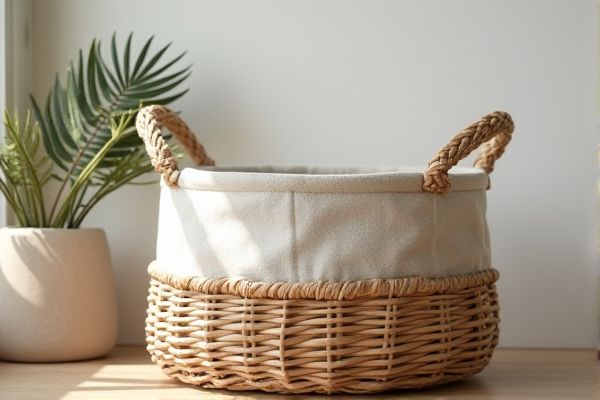
Decorative baskets offer a stylish, natural look perfect for enhancing home aesthetics, while fabric bins provide lightweight, collapsible storage solutions that are easy to carry and clean. Discover which option suits Your storage needs and interior style best by reading the rest of the article.
Table of Comparison
| Feature | Decorative Basket | Fabric Bin |
|---|---|---|
| Material | Wicker, rattan, or natural fibers | Cloth, canvas, polyester |
| Durability | Sturdy, long-lasting | Flexible, less durable |
| Design | Rustic, aesthetic appeal | Modern, versatile patterns |
| Weight | Heavier | Lightweight |
| Storage Capacity | Fixed shape, limited flexibility | Expandable, folds flat when empty |
| Maintenance | Clean with dry cloth | Machine washable or spot clean |
| Use Cases | Home decor, display, organizing | Closet storage, toys, laundry |
| Price Range | Moderate to high | Low to moderate |
Introduction to Decorative Baskets and Fabric Bins
Decorative baskets often feature natural materials like wicker, rattan, or seagrass, making them ideal for adding texture and warmth to living spaces. Fabric bins, typically made from cotton, polyester, or canvas, offer lightweight, foldable storage options that come in a variety of colors and patterns to match modern decor. Both storage solutions enhance organization while contributing to aesthetic appeal, but their material composition and design versatility cater to different functional and stylistic preferences.
Material Composition: Natural vs Synthetic
Decorative baskets are typically crafted from natural materials such as wicker, rattan, or seagrass, offering a rustic and eco-friendly aesthetic that enhances your home decor. Fabric bins usually consist of synthetic fibers like polyester or nylon, providing durability, lightweight convenience, and resistance to stains and moisture. Choosing between these options depends on your preference for natural textures or the practicality of synthetic materials in your storage solutions.
Aesthetic Appeal and Style Options
Decorative baskets often feature natural materials like wicker or rattan, adding a rustic, organic aesthetic that complements bohemian or farmhouse-style interiors. Fabric bins provide a broader range of colors, patterns, and textures, allowing you to easily match modern, minimalist, or eclectic decor themes. Your choice depends on whether you prefer the timeless charm of woven baskets or the versatile style options offered by fabric storage solutions.
Durability and Longevity
Decorative baskets, often crafted from natural materials like wicker or rattan, offer durability suitable for lightweight storage but may degrade faster when exposed to moisture or heavy use. Fabric bins, typically made from reinforced cloth or canvas, provide greater flexibility and resistance to wear, increasing their longevity in various environments including damp or high-traffic areas. Choosing the right option depends on your storage needs, with fabric bins generally outlasting decorative baskets under consistent use.
Storage Capacity and Flexibility
Decorative baskets often offer varying storage capacities depending on their size and material, making them ideal for displaying items while maintaining aesthetic appeal. Fabric bins provide greater flexibility due to their lightweight, collapsible design and typically larger storage volume, accommodating a wide range of household goods. Your choice should consider whether you prioritize versatile, space-efficient storage or a stylish container that complements your decor.
Maintenance and Cleaning Requirements
Decorative baskets, often made from natural materials like wicker or rattan, require regular dusting and occasional spot cleaning with a damp cloth to maintain their appearance, but they are generally more susceptible to moisture damage. Fabric bins, constructed from materials such as cotton or polyester, are typically machine washable or can be easily wiped down, making them more convenient for frequent cleaning in environments prone to spills or dirt. Both storage options offer distinct maintenance benefits depending on the level of exposure to dust and liquids.
Cost Analysis: Budget vs Premium
Decorative baskets generally offer a budget-friendly option with natural materials like rattan or wicker, providing an affordable yet stylish storage solution. Fabric bins tend to occupy the premium segment due to their customization options, diverse patterns, and durability features such as reinforced stitching and water-resistant fabrics. Cost analysis highlights that choosing between decorative baskets and fabric bins depends on balancing initial investment against long-term utility and aesthetic preferences.
Sustainability and Eco-Friendliness
Decorative baskets often utilize natural materials such as wicker, bamboo, or seagrass, which are biodegradable and sustainable, making them an eco-friendly storage option. Fabric bins, typically made from cotton or recycled polyester, offer durability and can be reused multiple times, reducing the need for single-use storage while some synthetic choices may impact environmental sustainability. Choosing natural fibers or recycled fabrics enhances the eco-friendliness of fabric bins, whereas decorative baskets' renewable resources contribute to minimal environmental footprint through compostability and reduced plastic waste.
Best Use Cases for Each Option
Decorative baskets excel in enhancing aesthetic appeal while providing lightweight storage for items like magazines, blankets, or toys, making them ideal for living rooms and bedrooms. Fabric bins offer versatile, collapsible storage solutions perfect for organizing clothing, accessories, or office supplies in closets and shelves, maximizing space efficiently. Your choice depends on whether you prioritize visual charm with easy access or flexible, space-saving organization.
Conclusion: Choosing the Right Storage Solution
Decorative baskets provide a stylish and natural aesthetic ideal for displaying items in living spaces, while fabric bins offer lightweight, collapsible, and versatile storage perfect for closets and children's rooms. Consider the intended use, durability needs, and space constraints when selecting between these solutions. Selecting the right storage option enhances organization and complements interior design effectively.
 homyna.com
homyna.com